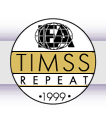
 |
|
|
Return to the Press Information page Media Contact: Patricia
Delaney Director of Media Relations TIMSS Project Contact: MEDIA NOTE: The full TIMSS 1999 reports are available on-line at the International Study Center's web site on the Publications page or by calling 617-552-1600. To arrange interviews with the TIMSS International Study CO-Directors Michael O. Martin or Ina V.S. Mullis, or to obtain camera-ready color charts, please call the Boston College Office of Public Affairs at 617-552-3352.
|
|
Statement by Dr. Alejandro Tiana In my presentation, I will address the issue of why countries decide to participate in a study like TIMSS, and how these countries benefit from that participation. The IEA has been conducting international studies aimed at evaluating educational achievement for more than forty years now, with more than sixty countries having participated in those comparative surveys. The main purpose of IEA has always been to provide policy makers and educational practitioners with information and indicators about their national education systems from an international perspective. This information has been related to basic school subjects (mathematics, language, and science), but also to other relevant areas of educational activity (for instance, preprimary policies and practices, use of information technology in education, and civic education). IEA's aim has been not only to provide indicators about achievement in such subjects and areas, but also to search for explanations of that achievement. That is the reason why the studies are not simply based in tests, but also include different questionnaires for collecting data about school and classroom process variables, as well as teacher and student background variables. TIMSS is an excellent example of the type of benefits countries may derive from participating in such studies. Making comparisons in an international perspective Countries participating in IEA studies receive relevant information
about the state of their education systems from an international perspective.
This can also be referred to as the "mirror" function of international
studies.
Searching for reasons of achievement The whole set of TIMSS indicators provides a much more detailed picture than just a gross measure of achievement. This is one of the most attractive features of TIMSS, because the multiple indicators allow countries to make detailed national analyses and obtain valuable information about their education systems from an international perspective. The number and variety of data provided do not lead to making simple, straightforward comparisons, but to taking into account the complexity of education practices and outcomes, and detecting the various strong and weak points within one's own country. It is necessary to recognize that educational research has not developed
to the point of providing policy makers and educators with definitive
explanations for differences in achievement. Nevertheless, studies like
TIMSS do point to several factors affecting achievement. For example,
the results indicate that teaching practices, interruptions from outside
the classroom, and teachers' confidence in their preparation to teach
mathematics are more closely related to students' outcomes in that subject
than simply providing more instructional time. TIMSS also shows students in classes emphasizing reasoning and problem-solving had higher achievement in mathematics than those in classes with a low emphasis on these activities. Moreover, students in schools well resourced got higher scores in both mathematics and science than those in schools with shortages in equipment. These kinds of analyses, even if still preliminary, may help countries examine their situations in relation to those factors identified as related to outcomes. In general terms, it can be said that the results of international studies do not lead to easy answers to complex educational problems, but they contribute to informed decision making by educational authorities and practitioners. To take full advantage of participating in such studies, countries should combine international results with national assessments and other national in-depth studies. IEA experience shows that this is a way followed by a growing number of countries, and it improves the immense possibilities of comparative achievement studies. – END – |
|
||||||||